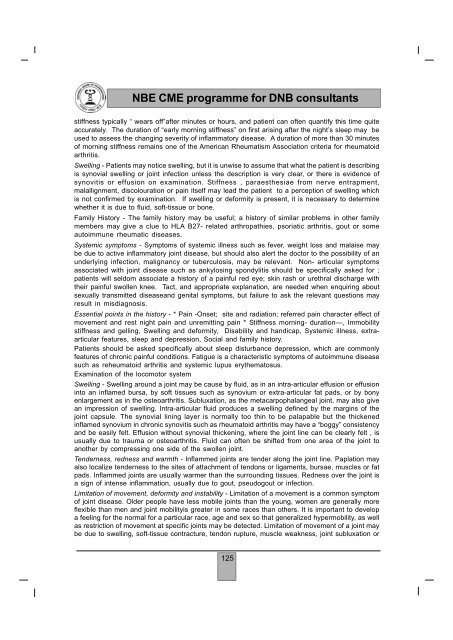NBE CME programme for DNB consultants - National Board Of ...
NBE CME programme for DNB consultants - National Board Of ...
NBE CME programme for DNB consultants - National Board Of ...
You also want an ePaper? Increase the reach of your titles
YUMPU automatically turns print PDFs into web optimized ePapers that Google loves.
<strong>NBE</strong> <strong>CME</strong> <strong>programme</strong> <strong>for</strong> <strong>DNB</strong> <strong>consultants</strong>stiffness typically “ wears off”after minutes or hours, and patient can often quantify this time quiteaccurately. The duration of “early morning stiffness” on first arising after the night’s sleep may beused to assess the changing severity of inflammatory disease. A duration of more than 30 minutesof morning stiffness remains one of the American Rheumatism Association criteria <strong>for</strong> rheumatoidarthritis.Swelling - Patients may notice swelling, but it is unwise to assume that what the patient is describingis synovial swelling or joint infection unless the description is very clear, or there is evidence ofsynovitis or effusion on examination. Stiffness , paraesthesiae from nerve entrapment,malallignment, discolouration or pain itself may lead the patient to a perception of swelling whichis not confirmed by examination. If swelling or de<strong>for</strong>mity is present, it is necessary to determinewhether it is due to fluid, soft-tissue or bone.Family History - The family history may be useful; a history of similar problems in other familymembers may give a clue to HLA B27- related arthropathies, psoriatic arthritis, gout or someautoimmune rheumatic diseases.Systemic symptoms - Symptoms of systemic illness such as fever, weight loss and malaise maybe due to active inflammatory joint disease, but should also alert the doctor to the possibility of anunderlying infection, malignancy or tuberculosis, may be relevant. Non- articular symptomsassociated with joint disease such as ankylosing spondylitis should be specifically asked <strong>for</strong> ;patients will seldom associate a history of a painful red eye; skin rash or urethral discharge withtheir painful swollen knee. Tact, and appropriate explanation, are needed when enquiring aboutsexually transmitted diseaseand genital symptoms, but failure to ask the relevant questions mayresult in misdiagnosis.Essential points in the history - * Pain -Onset; site and radiation; referred pain character effect ofmovement and rest night pain and unremitting pain * Stiffness morning- duration—, Immobilitystiffness and gelling, Swelling and de<strong>for</strong>mity, Disability and handicap, Systemic illness, extraarticularfeatures, sleep and depression, Social and family history.Patients should be asked specifically about sleep disturbance depression, which are commonlyfeatures of chronic painful conditions. Fatigue is a characteristic symptoms of autoimmune diseasesuch as reheumatoid arthritis and systemic lupus erythematosus.Examination of the locomotor systemSwelling - Swelling around a joint may be cause by fluid, as in an intra-articular effusion or effusioninto an inflamed bursa, by soft tissues such as synovium or extra-articular fat pads, or by bonyenlargement as in the osteoarthritis. Subluxation, as the metacarpophalangeal joint, may also givean impression of swelling. Intra-articular fluid produces a swelling defined by the margins of thejoint capsule. The synovial lining layer is normally too thin to be palapable but the thickenedinflamed synovium in chronic synovitis such as rheumatoid arthritis may have a “boggy” consistencyand be easily felt. Effusion without synovial thickening, where the joint line can be clearly felt , isusually due to trauma or osteoarthritis. Fluid can often be shifted from one area of the joint toanother by compressing one side of the swollen joint.Tenderness, redness and warmth - Inflammed joints are tender along the joint line. Paplation mayalso localize tenderness to the sites of attachment of tendons or ligaments, bursae, muscles or fatpads. Inflammed joints are usually warmer than the surrounding tissues. Redness over the joint isa sign of intense inflammation, usually due to gout, pseudogout or infection.Limitation of movement, de<strong>for</strong>mity and instability - Limitation of a movement is a common symptomof joint disease. Older people have less mobile joints than the young, women are generally moreflexible than men and joint mobilityis greater in some races than others. It is important to developa feeling <strong>for</strong> the normal <strong>for</strong> a particular race, age and sex so that generalized hypermobility, as wellas restriction of movement at specific joints may be detected. Limitation of movement of a joint maybe due to swelling, soft-tissue contracture, tendon rupture, muscle weakness, joint subluxation or125
















